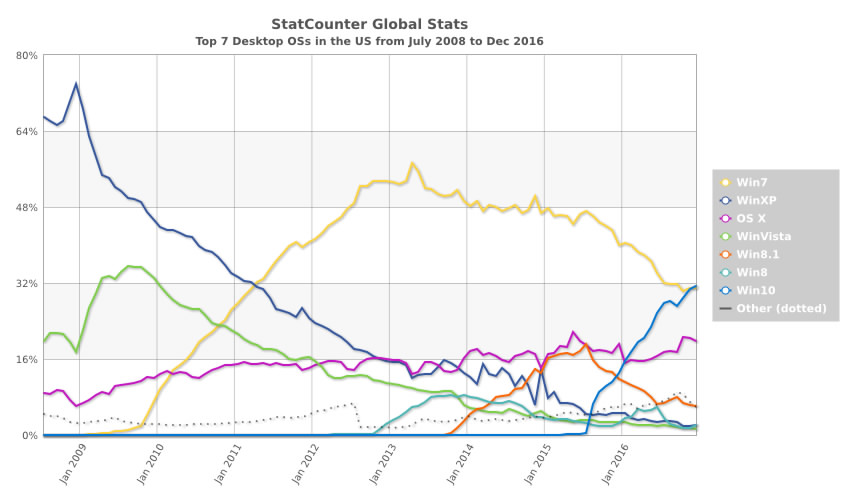
Tech & Sci
22:00, 03-Jan-2017
Windows 10 most used desktop OS in UK and US
Updated
10:31, 28-Jun-2018

After a year of free-to-upgrade promotion, Microsoft has managed to make Windows 10 the most used operating system (OS) in desktop computers in the United Kingdom and the United States, according to data published by StatCounter.

Usage count distribution of US desktop computer operating systems between 2008 and 2016. /StatCounter
Usage count distribution of US desktop computer operating systems between 2008 and 2016. /StatCounter

Usage count distribution of UK desktop computer operating systems between 2008 and 2016. /StatCounter
Usage count distribution of UK desktop computer operating systems between 2008 and 2016. /StatCounter
The adoption of new OS versions is not always fluent. Microsoft has previously struggled to convince its users to upgrade. As the above charts show, Windows 8 and 8.1 had a relatively short life-cycle, and never peaked above 20 percent of usage in the US.
To reverse the trend, Microsoft launched a campaign after the introduction of Windows 10 to allow previous Windows users to upgrade their system at no extra cost.

A Microsoft employee introduces the company's new products in New York City, October 26, 2016. /CFP Photo
A Microsoft employee introduces the company's new products in New York City, October 26, 2016. /CFP Photo
Another reason for the quick adoption of Windows 10 might be the widely held belief that electronic devices or OS versions should be upgraded every two generations rather than one. Those following this advice skip the version which introduces bold, ambitious new features, and wait until the product becomes matured.
Android has suffered a similar problem. As of August 2016, this most-used smartphone OS still saw more users hooked on its 4.4 and 5.1 versions, instead of the latest 6.0, according to official data from the Android Developers website.

Adoption ratio of different versions of Android, as of August 2016. /Android Developers
Adoption ratio of different versions of Android, as of August 2016. /Android Developers

SITEMAP
Copyright © 2018 CGTN. Beijing ICP prepared NO.16065310-3
Copyright © 2018 CGTN. Beijing ICP prepared NO.16065310-3